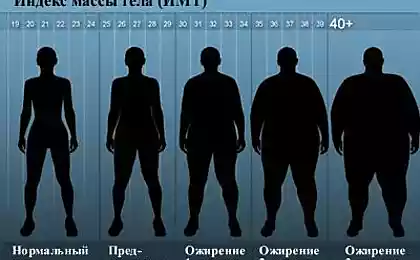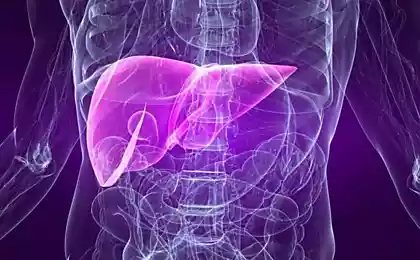645
How to distinguish between healthy and unhealthy excess of body weight
Talk about a healthy fat (low-fat) people. Yes, these people are. To define this group of patients 1982 he was offered the term "metabolically healthy obese" (MLO). In principle, it is possible to have an excess of body weight up to 15% and have no complications. As a rule, it concerns mainly women. Let's see how to distinguish between healthy and unhealthy excess of body weight.
Thirty four million five hundred thirty three thousand two hundred eighty nine
Currently, the researchers is of particular interest in the phenotype of the disease, dubbed "metabolically healthy obese" (MLO). Interchangeably uses the terms "metabolically benign", "metabolically normal and metabolically protected", "insulinchuvstvitelnyh", "uncomplicated" obesity or "obesity without cardiovascular risk factors".
Forty million five hundred seventy two thousand five hundred seventy four
True MLO without clinical and subclinical risk factors is a rather rare phenomenon, its actual prevalence may not exceed 5-15% among patients with BMI > 30 kg/m2 the Prevalence of obesity without cardiometabolic risk factors in women ranged from 7% (Finland) to 28% (Norway), in men — from 2% (Finland) to 19% (Italy).
Among patients with obesity regarded as metabolically healthy given the presence they have no more than one of the 6 cardio-metabolic risk factors — increased blood pressure, triglyceride levels, fasting glucose levels, CRP, and decrease in high density lipoprotein and insulin sensitivity.
With more stringent criteria — the lack of 6 factors — the group MLO was attributed only 16.6% of obese patients. In the same sample, change the threshold values of HOMA index from 5.1 to 2.5 resulted in a reduction in the number of patients with metabolically normal obesity to 6%.
The people are the same weight and height can either be fat or unhealthy to be healthy fat. Here, let's look at an example: in the illustration below, two women, 34 and 39 years old. The body mass index of both above 30 (obesity), the total body weight and fat – are the same. But left women healthy obese, and the right is unhealthy. Caught a difference already? Different shapes and different distribution of fat. The right women are much more "bad" visceral fat, which causes all the problems.
Eighteen million six hundred nine thousand eight hundred forty nine
I once again remind you that visceral and subcutaneous fat is completely different tkanie, which even have different origins. The "fat bottom", "healthy" subcutaneous no effect on inflammation does not cause disease. On the contrary, protects from them.
Ninety seven million one hundred twenty six thousand six hundred ten
Criteria healthy overweight.
1. Stored the metabolism.
Presumably, preserved insulin sensitivity, high activity level, and genetic features underlie differences MLO from metabolically unhealthy obesity. Therefore, insulin levels (and sensitivity to it), leptin, adiponectin and C-reactive protein should be normal. No signs of metabolic syndrome(!).
2. Normal level of visceral fat.
Slowly progressive inflammation of adipose tissue is a key pathogenic factor in metabolic diseases. Compared to the metabolically unhealthy obese phenotype of MLO is characterized by a more favorable profile of inflammation in adipose tissue, the smaller volume of the visceral depot, is less pronounced inltration by macrophages, smaller adipocytes.
Studies using imaging techniques showed that the volume of visceral adipose tissue on MLO 50% less than patients with metabolic disorders. Hypertrophic obesity (increase in size of adipocytes) are more closely associated with insulin resistance than hyperplastic obesity (increased number of fat cells).
The amount of fat on the human body is less important than the type of fat and how it is distributed. It is believed that an increased amount of visceral fat (fat surrounding the internal organs) is directly related to the increase in the content of fat in the bloodstream that can lead to common diseases such as hyperlipidemia and diabetes, which don't allow insulin to transfer energy from the bloodstream and use it in cells.
People with high levels of visceral fat usually have a big belly. To avoid common ailments or to boost immunity, you need to lower the amount of visceral fat to an acceptable level.
3. Low fat liver and other internal organs (as part of the visceral obesity)
Nairana healthy liver is the key to understanding zdorvogo weight! The presence of ectopic fat in skeletal muscle and liver in patients with low MLO. Low content of fatty tissue in the liver is regarded as extremely reliable indicator of metabolic health.
Fibrosis of the adipose tissue, determined by the level of expression of collagen 6 type, is substantially less pronounced, when MLO, which contributes to the higher plasticity of adipose tissue, its ability to healthy expansion. In the work of A. D. Ogorodnikova et al. (2013) shows that the contents of the epikardial - Noah, intrahepatic fat and pericardial tissue in MLO is less than that of patients with obesity in combination with metabolic disorders.
4. Low level chronic systemic inflammation.
Pathophysiological basis of obesity and associated diseases is a chronic, slowly progressive inflammation. However, not all patients with obesity, marked metabolic disturbances from 10 to 40% of patients have intact carbohydrate metabolism, lipid profile, blood pressure.
At the same time, 10-27% of individuals with normal body weight and insulin resistance occur dyslipidemia. So that you can be fat and thin and normal body weight, but more on that later.
But! Total fat cannot grow indefinitely, when a considerable excess of it will go to visceral. So if metabolically healthy overweight people will reduce physical activity or start eating more, they get sick.
Came sweeeee a study in which participated 58 pairs of twins, and it was found that men active the accumulation of visceral fat occurs at a 20.6 per cent body fat in women upon reaching 39,4% (along the way (well, not quite simultaneously, because that is what was the original purpose of the study), it was concluded that the accumulation of visceral fat in adults is not the result of genetic predisposition, but is rather the result of the increase in total body fat).
Also, given that percent body fat was determined using DEXA, and it is a more accurate method than the thickness of the folds or bioimpedance, and DEXA data is always higher than data obtained by using the measurements of the folds or bioimpendance, in fact the results of this research again leads us to articulate the rule "not to rastiratsa above 15% for men."
Also, with age, excess weight also makes itself known: reduced physical activity and slowed metabolism. Good and fat is bad. Health problems fat people have become more obvious after about 15 years. There is the view that the absence of disease — is only a temporary phenomenon, and subsequently, any person with obesity will get the usual bouquet of diabetes, heart problems, etc.
This is consistent with the data of several works, like the one that was recently published in the Journal of the American College of Cardiology. That is, metabolically healthy obese such people are actually not so healthy and can be the initial stage on the way to serious ailments. However, evidence suggests that "good" and "bad" obesity really represent two different physiological conditions, and that "good" obesity is not necessarily a precursor to "bad".
Of course, this does not mean that patients with metabolically healthy phenotype do not need treatment; excessive weight many of them determines the development of osteoarthritis, sleep apnea syndrome and other complications and associated diseases.
In addition, the MLO is not a stable condition in many patients over time, a deterioration of metabolic parameters. As noted by S. L. Appleton et al. (2013), 8 years after the initial survey of metabolic health were able to save patients by maintaining a healthy lifestyle has not changed indicators of waist circumference.
Eighty seven million ninety six thousand six hundred fourteen
5. Stored physical activity.
Higher level of physical activity is associated with a metabolically healthy phenotype. As noted by S. M. Camhi et al. (2013), every minute of physical activity increases the chances to maintain metabolic health by 36%.
It turned out that if the people do not forget about exercise and keep myself in good shape, they show no health problems traditionally associated with being overweight, like diabetes, high cholesterol or hypertension.
Published in the European Heart journal study suggests that doctors have in determining health risks fat people to first ask them, whether they practiced any physical activity. There are a large number of obese people who are protected from these metabolic complications associated with obesity.
The fitness regime they train the heart and other organs, making them more durable and resistant to disease." Thin, but received a people, have the risk of earlier death than their sports counterparts.
6. The normal level of hemoxygenase-1 (HO-1).
It can serve as one of the earliest markers of metabolic disorders. These results are consistent with the data obtained Naukkarinen Jussi (Jussi Naukkarinen) and his colleagues from Helsinki University, who performed last year with the message about what healthy and unhealthy obesity differ in the number and level of inflammation.
Apparently, this enzyme separates healthy and unhealthy overweight. However, the authors specify that his level is full of people, even with normal insulin sensitivity was still higher than in lean. That is, the excess weight still is not "perfectly healthy", and the risk of diabetes with excess weight in any case increased.
7. Healthy diet.
Some biologically active components included in food composition (polyphenols, polyunsaturated fatty acids, vitamins A, D, E), due to its antioxidant and anti-inflammatory properties may have a favourable impact on the pathogenetic factors of obesity and metabolic syndrome. Laboratory and clinical studies have confirmed the positive effect of a number of nutrients on differentiation of adipocytes, lipid metabolism
Forty four million two hundred twenty thousand seven hundred forty seven
8. Genetic predisposition (missing).
To clarify the mechanisms that underpin metabolic health, conducted a search for genes that regulate the differentiation and plasticity of adipocytes, particularly the distribution of adipose tissue and the reaction slowly progressive inflammation. In patients with MLO gene expression protein 2, uncoupling oxidative phosphorylation, receptor gene gene PPAR5 and hormone-sensitive lipase was higher than in complicated obesity [53].
In the work of A. Jais et al. (2014) have shown that the MLO in the liver and adipose tissue shows the lowest expression of the gene of hemoxygenase-1 — a protein involved in the realization of oxidative stress.
J. Naukkarinen et al. (2014) conducted a unique study of 16 pairs of monozygotic twins discordant for body mass (difference in average 17 kg). Observed were divided into 2 groups (8 pairs of twins in each) depending on the metabolic state of health of participants with obesity.
Compared with their healthy brothers (sisters), patients with obesity in combination with metabolic disorders had a much higher fat content in the liver (18%), larger size of adipocytes; adipose tissue had low expression of genes involved in the metabolism of short-chain amino acids, oxidation of fatty acids.
In addition, in this subgroup, an infringement of mitochondrial biogenesis. Participants phenotype of MLO on all these parameters did not differ from their twins.
It turned out that all twins can be divided into 2 groups according to the number of fat accumulated in the liver. So, part of obese subjects with the same amount of fat in the liver as lean twins, no health problems were observed. The other part of the people (with a lot of fat in the liver) worked genes causing inflammatory reaction, simultaneously suppressed the activity of mitochondria.
What are the symptoms of anterior scalene muscle and the consequences?
Intrusive negative thoughts — WHAT to DO
According to researchers, in addition to genes of a certain contribution to the formation of a metabolically healthy phenotype can make and a healthy way of life: the twins without cardio-metabolic risk factors was a higher level of physical activity.
Thus, the scientists were able to characterize two types of possible obesity in humans, healthy and unhealthy, one of the main differences between them was the number and nature of fat deposits in the liver.
Conclusion.
Healthy obesity is not a myth but a real condition. But to confirm it, you must comply with all these criteria.
Author: Andrey Blueskin
P. S. And remember, only by changing their consumption — together we change the world! ©
Source: www.beloveshkin.com/2015/07/zdorovoe-ozhirenie-i-ego-kriterii.html
Thirty four million five hundred thirty three thousand two hundred eighty nine
Currently, the researchers is of particular interest in the phenotype of the disease, dubbed "metabolically healthy obese" (MLO). Interchangeably uses the terms "metabolically benign", "metabolically normal and metabolically protected", "insulinchuvstvitelnyh", "uncomplicated" obesity or "obesity without cardiovascular risk factors".
Forty million five hundred seventy two thousand five hundred seventy four
True MLO without clinical and subclinical risk factors is a rather rare phenomenon, its actual prevalence may not exceed 5-15% among patients with BMI > 30 kg/m2 the Prevalence of obesity without cardiometabolic risk factors in women ranged from 7% (Finland) to 28% (Norway), in men — from 2% (Finland) to 19% (Italy).
Among patients with obesity regarded as metabolically healthy given the presence they have no more than one of the 6 cardio-metabolic risk factors — increased blood pressure, triglyceride levels, fasting glucose levels, CRP, and decrease in high density lipoprotein and insulin sensitivity.
With more stringent criteria — the lack of 6 factors — the group MLO was attributed only 16.6% of obese patients. In the same sample, change the threshold values of HOMA index from 5.1 to 2.5 resulted in a reduction in the number of patients with metabolically normal obesity to 6%.
The people are the same weight and height can either be fat or unhealthy to be healthy fat. Here, let's look at an example: in the illustration below, two women, 34 and 39 years old. The body mass index of both above 30 (obesity), the total body weight and fat – are the same. But left women healthy obese, and the right is unhealthy. Caught a difference already? Different shapes and different distribution of fat. The right women are much more "bad" visceral fat, which causes all the problems.
Eighteen million six hundred nine thousand eight hundred forty nine
I once again remind you that visceral and subcutaneous fat is completely different tkanie, which even have different origins. The "fat bottom", "healthy" subcutaneous no effect on inflammation does not cause disease. On the contrary, protects from them.
Ninety seven million one hundred twenty six thousand six hundred ten
Criteria healthy overweight.
1. Stored the metabolism.
Presumably, preserved insulin sensitivity, high activity level, and genetic features underlie differences MLO from metabolically unhealthy obesity. Therefore, insulin levels (and sensitivity to it), leptin, adiponectin and C-reactive protein should be normal. No signs of metabolic syndrome(!).
2. Normal level of visceral fat.
Slowly progressive inflammation of adipose tissue is a key pathogenic factor in metabolic diseases. Compared to the metabolically unhealthy obese phenotype of MLO is characterized by a more favorable profile of inflammation in adipose tissue, the smaller volume of the visceral depot, is less pronounced inltration by macrophages, smaller adipocytes.
Studies using imaging techniques showed that the volume of visceral adipose tissue on MLO 50% less than patients with metabolic disorders. Hypertrophic obesity (increase in size of adipocytes) are more closely associated with insulin resistance than hyperplastic obesity (increased number of fat cells).
The amount of fat on the human body is less important than the type of fat and how it is distributed. It is believed that an increased amount of visceral fat (fat surrounding the internal organs) is directly related to the increase in the content of fat in the bloodstream that can lead to common diseases such as hyperlipidemia and diabetes, which don't allow insulin to transfer energy from the bloodstream and use it in cells.
People with high levels of visceral fat usually have a big belly. To avoid common ailments or to boost immunity, you need to lower the amount of visceral fat to an acceptable level.
3. Low fat liver and other internal organs (as part of the visceral obesity)
Nairana healthy liver is the key to understanding zdorvogo weight! The presence of ectopic fat in skeletal muscle and liver in patients with low MLO. Low content of fatty tissue in the liver is regarded as extremely reliable indicator of metabolic health.
Fibrosis of the adipose tissue, determined by the level of expression of collagen 6 type, is substantially less pronounced, when MLO, which contributes to the higher plasticity of adipose tissue, its ability to healthy expansion. In the work of A. D. Ogorodnikova et al. (2013) shows that the contents of the epikardial - Noah, intrahepatic fat and pericardial tissue in MLO is less than that of patients with obesity in combination with metabolic disorders.
4. Low level chronic systemic inflammation.
Pathophysiological basis of obesity and associated diseases is a chronic, slowly progressive inflammation. However, not all patients with obesity, marked metabolic disturbances from 10 to 40% of patients have intact carbohydrate metabolism, lipid profile, blood pressure.
At the same time, 10-27% of individuals with normal body weight and insulin resistance occur dyslipidemia. So that you can be fat and thin and normal body weight, but more on that later.
But! Total fat cannot grow indefinitely, when a considerable excess of it will go to visceral. So if metabolically healthy overweight people will reduce physical activity or start eating more, they get sick.
Came sweeeee a study in which participated 58 pairs of twins, and it was found that men active the accumulation of visceral fat occurs at a 20.6 per cent body fat in women upon reaching 39,4% (along the way (well, not quite simultaneously, because that is what was the original purpose of the study), it was concluded that the accumulation of visceral fat in adults is not the result of genetic predisposition, but is rather the result of the increase in total body fat).
Also, given that percent body fat was determined using DEXA, and it is a more accurate method than the thickness of the folds or bioimpedance, and DEXA data is always higher than data obtained by using the measurements of the folds or bioimpendance, in fact the results of this research again leads us to articulate the rule "not to rastiratsa above 15% for men."
Also, with age, excess weight also makes itself known: reduced physical activity and slowed metabolism. Good and fat is bad. Health problems fat people have become more obvious after about 15 years. There is the view that the absence of disease — is only a temporary phenomenon, and subsequently, any person with obesity will get the usual bouquet of diabetes, heart problems, etc.
This is consistent with the data of several works, like the one that was recently published in the Journal of the American College of Cardiology. That is, metabolically healthy obese such people are actually not so healthy and can be the initial stage on the way to serious ailments. However, evidence suggests that "good" and "bad" obesity really represent two different physiological conditions, and that "good" obesity is not necessarily a precursor to "bad".
Of course, this does not mean that patients with metabolically healthy phenotype do not need treatment; excessive weight many of them determines the development of osteoarthritis, sleep apnea syndrome and other complications and associated diseases.
In addition, the MLO is not a stable condition in many patients over time, a deterioration of metabolic parameters. As noted by S. L. Appleton et al. (2013), 8 years after the initial survey of metabolic health were able to save patients by maintaining a healthy lifestyle has not changed indicators of waist circumference.
Eighty seven million ninety six thousand six hundred fourteen
5. Stored physical activity.
Higher level of physical activity is associated with a metabolically healthy phenotype. As noted by S. M. Camhi et al. (2013), every minute of physical activity increases the chances to maintain metabolic health by 36%.
It turned out that if the people do not forget about exercise and keep myself in good shape, they show no health problems traditionally associated with being overweight, like diabetes, high cholesterol or hypertension.
Published in the European Heart journal study suggests that doctors have in determining health risks fat people to first ask them, whether they practiced any physical activity. There are a large number of obese people who are protected from these metabolic complications associated with obesity.
The fitness regime they train the heart and other organs, making them more durable and resistant to disease." Thin, but received a people, have the risk of earlier death than their sports counterparts.
6. The normal level of hemoxygenase-1 (HO-1).
It can serve as one of the earliest markers of metabolic disorders. These results are consistent with the data obtained Naukkarinen Jussi (Jussi Naukkarinen) and his colleagues from Helsinki University, who performed last year with the message about what healthy and unhealthy obesity differ in the number and level of inflammation.
Apparently, this enzyme separates healthy and unhealthy overweight. However, the authors specify that his level is full of people, even with normal insulin sensitivity was still higher than in lean. That is, the excess weight still is not "perfectly healthy", and the risk of diabetes with excess weight in any case increased.
7. Healthy diet.
Some biologically active components included in food composition (polyphenols, polyunsaturated fatty acids, vitamins A, D, E), due to its antioxidant and anti-inflammatory properties may have a favourable impact on the pathogenetic factors of obesity and metabolic syndrome. Laboratory and clinical studies have confirmed the positive effect of a number of nutrients on differentiation of adipocytes, lipid metabolism
Forty four million two hundred twenty thousand seven hundred forty seven
8. Genetic predisposition (missing).
To clarify the mechanisms that underpin metabolic health, conducted a search for genes that regulate the differentiation and plasticity of adipocytes, particularly the distribution of adipose tissue and the reaction slowly progressive inflammation. In patients with MLO gene expression protein 2, uncoupling oxidative phosphorylation, receptor gene gene PPAR5 and hormone-sensitive lipase was higher than in complicated obesity [53].
In the work of A. Jais et al. (2014) have shown that the MLO in the liver and adipose tissue shows the lowest expression of the gene of hemoxygenase-1 — a protein involved in the realization of oxidative stress.
J. Naukkarinen et al. (2014) conducted a unique study of 16 pairs of monozygotic twins discordant for body mass (difference in average 17 kg). Observed were divided into 2 groups (8 pairs of twins in each) depending on the metabolic state of health of participants with obesity.
Compared with their healthy brothers (sisters), patients with obesity in combination with metabolic disorders had a much higher fat content in the liver (18%), larger size of adipocytes; adipose tissue had low expression of genes involved in the metabolism of short-chain amino acids, oxidation of fatty acids.
In addition, in this subgroup, an infringement of mitochondrial biogenesis. Participants phenotype of MLO on all these parameters did not differ from their twins.
It turned out that all twins can be divided into 2 groups according to the number of fat accumulated in the liver. So, part of obese subjects with the same amount of fat in the liver as lean twins, no health problems were observed. The other part of the people (with a lot of fat in the liver) worked genes causing inflammatory reaction, simultaneously suppressed the activity of mitochondria.
What are the symptoms of anterior scalene muscle and the consequences?
Intrusive negative thoughts — WHAT to DO
According to researchers, in addition to genes of a certain contribution to the formation of a metabolically healthy phenotype can make and a healthy way of life: the twins without cardio-metabolic risk factors was a higher level of physical activity.
Thus, the scientists were able to characterize two types of possible obesity in humans, healthy and unhealthy, one of the main differences between them was the number and nature of fat deposits in the liver.
Conclusion.
Healthy obesity is not a myth but a real condition. But to confirm it, you must comply with all these criteria.
Author: Andrey Blueskin
P. S. And remember, only by changing their consumption — together we change the world! ©
Source: www.beloveshkin.com/2015/07/zdorovoe-ozhirenie-i-ego-kriterii.html
Electric cars are more efficient cars on hydrogen fuel
1 exercise that really relieves lower back pain! Rein sciatic nerve























